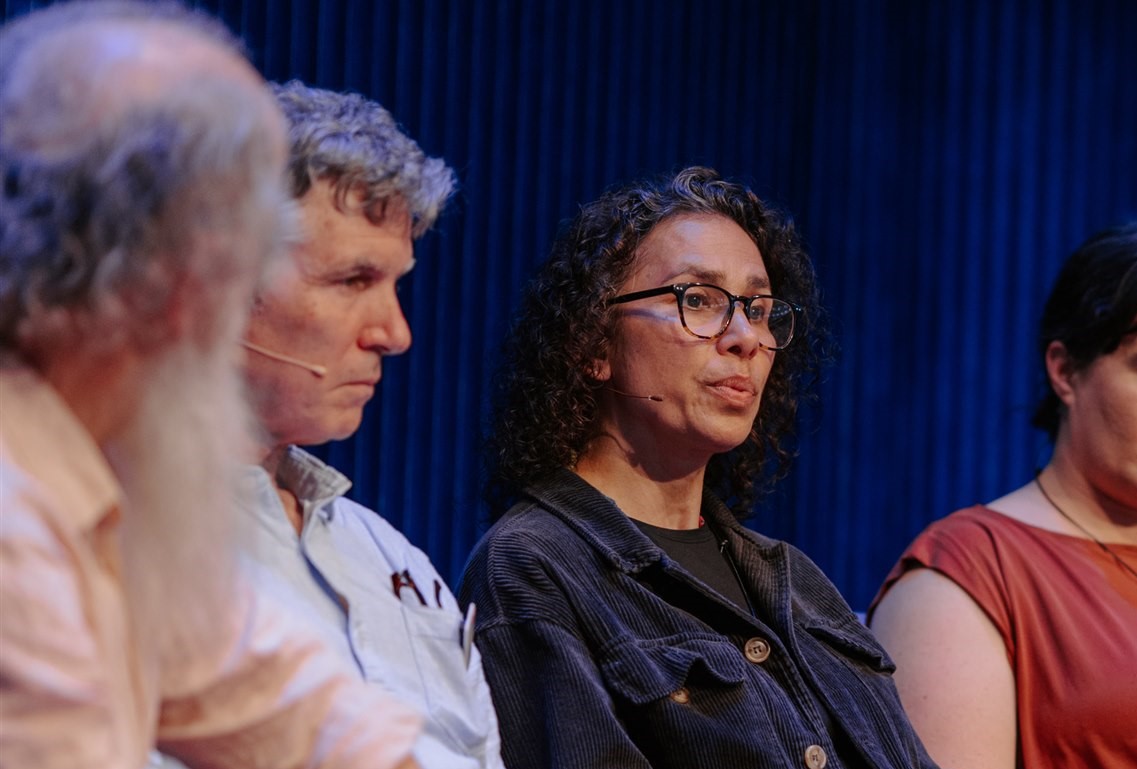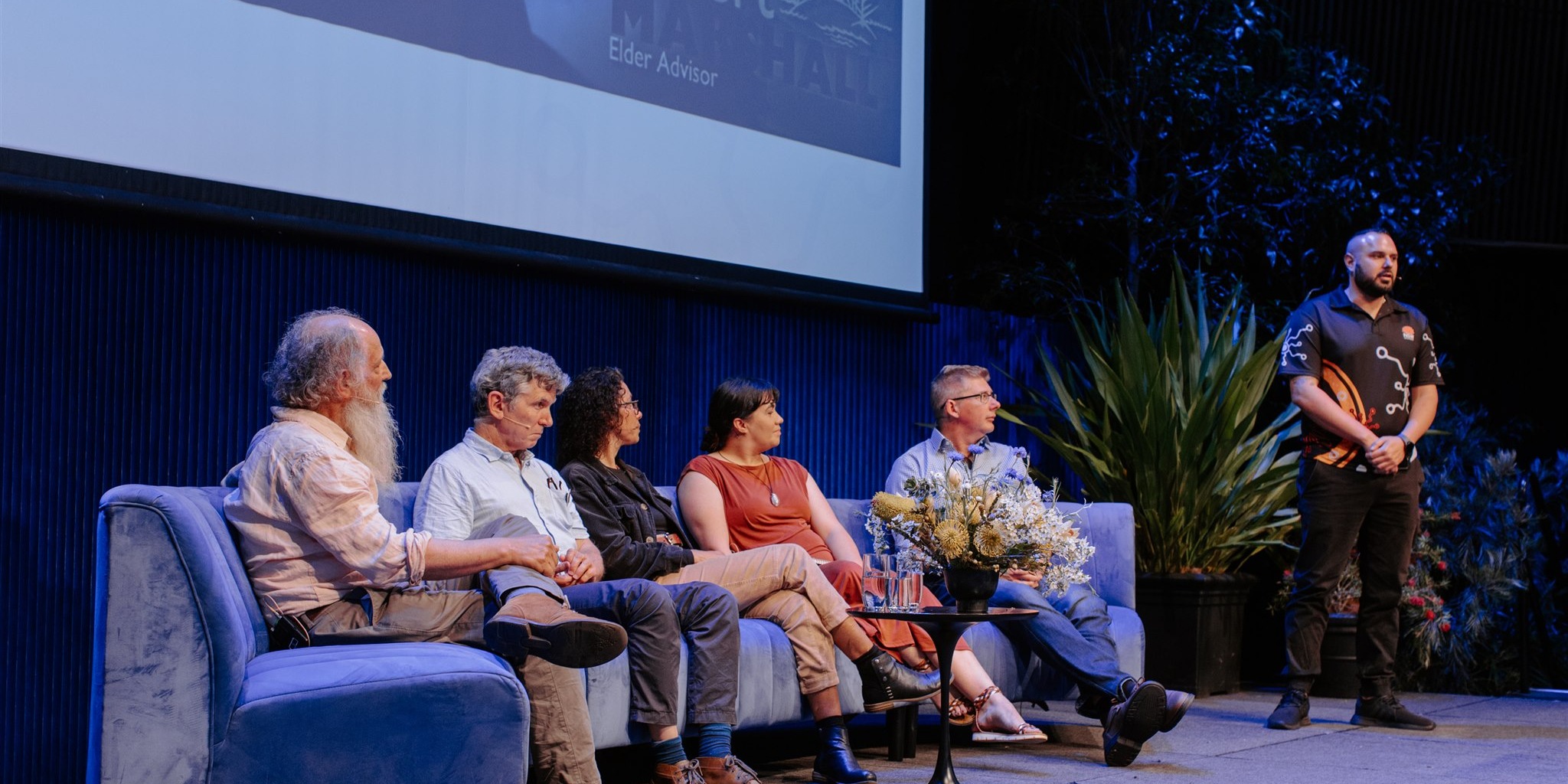When Dr Eren Turak was tasked with developing an ecological monitoring system to support cultural burning at the Rick Farley Reserve in far south western New South Wales , he thought he had a clear plan.
“Two-Eyed Seeing brings together two very different ways of addressing complexity.”
Dr Eren Turak, Principal Scientist, NSW Department of Climate Change, Energy, the Environment and Water
But after meeting Uncle Mick Kelly, the reserve’s manager and a Traditional Custodian, Eren’s approach shifted in ways he hadn’t anticipated.
As Eren outlined his scientific method, Uncle Mick shared his own vision – one that is connected young people to culture and Country. In a blink, Eren realised he needed to embrace a different approach.
“I decided to forget about my plan and work towards a common vision,” he told the audience during a panel session at the AdaptNSW 2024 Forum.
That night, the pair formed a new co-created vision for the project – one blending science with cultural values – and marking the beginning of Eren’s immersion into Two-Eyed Seeing.
Looking through two lenses
The Two-Eyed Seeing framework was developed by Mi’kmaq Elders Albert D. Marshall and Murdena Marshall from Eskasoni First Nation in collaboration with Cheryl Bartlett, a professor at Cape Breton University in Canada. At the heart of Two-Eyed Seeing, which is deeply rooted in Mi’kmaq culture, is the idea that Western science and Indigenous knowledge systems are not mutually exclusive. Rather, they complement each other, offering a fuller view of the world and its complexities.
As Mal Ridges, a Cultural Scientist with Department of Climate Change, Energy, the Environment and Water (DCCEEW), observed, it is not about blending two ways of seeing “because that just sends us cross-eyed”. Instead, it is about applying two perspectives “side by side”.
This integrated approach is being embraced in climate change research and practice, as scientists and diverse Indigenous communities with their diverse Indigenous knowledges work together to develop solutions that are both scientifically rigorous and culturally respectful.
“This isn't just about Aboriginal wisdom contributing to what was the past. This is about Aboriginal wisdom contributing to our future, and how we vision the world,” Mal said.
Insights from the world’s oldest storytellers
For Paris Goolagong (nee Norton), a DCCEEW Cultural Scientist of Gamilaroi and Ngati Kahungunu descent, Two-Eyed Seeing is an inherent part of her climate adaptation work. Paris is currently developing a cultural adaptation workbook =. The audience heard how Paris has been thinking about Two-Eyed Seeing from a cultural perspective. “One eye is Country, and the other is people,” she explained.
Michael Drielsma, who leads the ecological modelling team at DCCEEW, uses spatial models to guide biodiversity conservation and understand how landscapes are evolving.
“I come from a quite traditional Western science background,” Michael shared. Aware that the stories of climate change “weren’t getting across”, Michael began looking for alternatives and listening to Traditional Custodians.
“Aboriginal people have been here for over 65,000 years and they’re possibly the [world’s] first storytellers. We've got Western science, but we need these stories [to show another perspective of climate change].”
Trent Auld chaired the discussion. Trent, a Project Officer at DCCEEW, is of Aboriginal and Torres Strait Islander descent and was born and raised in the Illawarra community on Dharawal Country. “Aboriginal people were the first scientists of this continent,” Trent said as he set the scene. By understanding how Indigenous communities have passed down knowledge about the land through stories, observations and practices, we gain a deeper understanding of how to manage the challenges of climate change.

An open mind, an open heart
Amanda Close, a Cultural Scientist and Minjungbul, Githabul and Widjabul Wia-bul woman from the Northern Rivers of New South Wales, emphasised the “co-learning and collaborative” approach to Two-Eyed Seeing. “It is very much relationship based” and “about having an open mind which allows creative differences to work” to continue to resolve pressing climate change issues.
One of the most powerful aspects of Two-Eyed Seeing is its ability to break down complexity. Western science often tackles complex systems by breaking them down into smaller, manageable parts and using quantitative data on a small number of variables to arrive at conclusions, Eren noted. In contrast, Indigenous ways of knowing are based on qualitative information on a large number of variables, like seasonal changes, patterns in animal behaviour, and the interconnectedness of ecosystems.
“Climate change means more uncertainty and less controllability,” he says. “This is where we desperately need these two different approaches to dealing with complexity.”
“It’s about embracing the qualitative and the quantitative, the tangible and the intangible, the observing and sensing. These are all dimensions of Two-Eyed Seeing.”
Mal Ridges, Cultural Scientist, NSW Department of Climate Change, Energy, the Environment and Water
A clear call to action
Two-Eyed Seeing is not just an intellectual exercise; it’s a call to action. It challenges scientists, policy-makers and communities to rethink how they approach climate adaptation.
Etuaptmumk is the Mi'kmaw word for Two-Eyed Seeing, and the word means the “gift of multiple perspectives,” Paris observed.
“When a gift is offered culturally, that’s very much action -based. A gift ignites a relationship of reciprocity. It's about commitment, responsibility and creation. So, it's kind of a challenge… How do we take this concept, understand it, but action it as well?”
The answer lies in collaboration and mutual respect, the panel agreed.
“One of the challenges with climate change, I think, is that it's a global issue,” Mal Ridges said. Science has tended to “compartmentalise” but climate change has a universal impact. “Everybody is affected, which means everybody’s perspective is relevant.”
Check out more stories from the AdaptNSW Forum 2024.
AdaptNSW 2024 Forum
The AdaptNSW 2024 Forum, ‘deep understanding, bold action', attracted 500-plus attendees who heard from more than 100 presenters across 36 breakout, panel, workshop and keynote sessions in October 2024. Check out the program highlights and watch recordings of key sessions.
